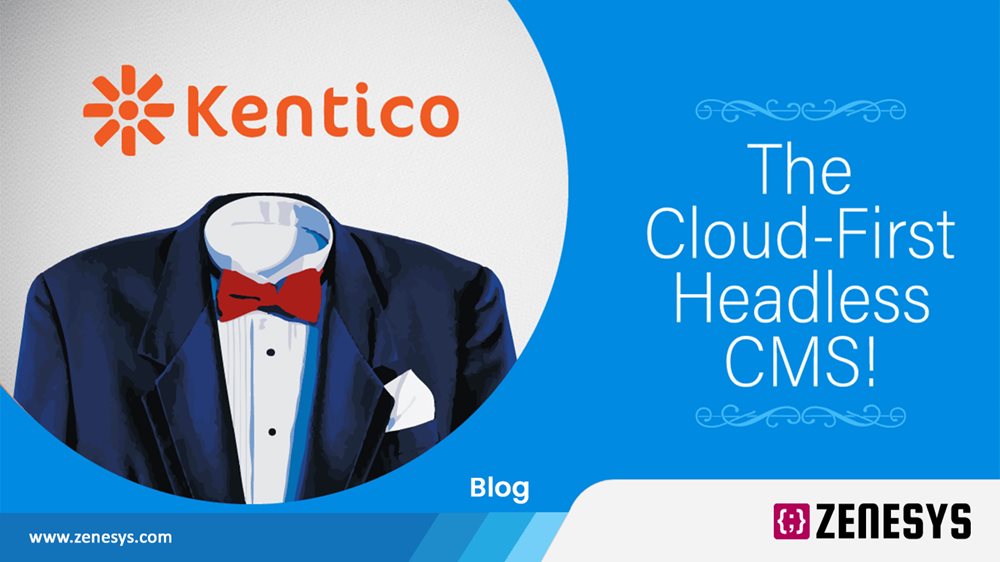Kentico has been one of the fasted growing CMS providers over the decade. Over the years Kentico has been trying to provide its users the best of CMS experience - be it for Kentico developers or for Kentico Managers.
Most traditional CMS architectures were based on a coupled architecture structure - The content repository, back-end user interface for editors, templating system, as well as your custom code were all one single application. While this seems to be easy to setup and Manage Coupled Architecture has its issues. So, CMS developers found the Decoupled Architecture that effectively was a way to separate out two environments the content management environment, usually protected by a firewall, where you make your changes, and a content delivery environment, with which you synchronize the content.
Though this was indeed effective, CMSs were built to manage websites but now most of the content is viewed on different devices. Comes in Headless CMS - Manage your content separately and deliver it to any device. The power of seamlessly being able to push content to any device is what makes Kentico Cloud so special.
Kentico has effectively separated the developers from the content mangers by the use of Application Program Interfaces (API).
.png?width=490&height=352)
So, what led to this change in Model? The Start of Headless
Issues with the Coupled Architecture
While the Single application structure of the coupled architecture was very popular being easily set up and manage on a single environment, the same posed some difficulties in the System.
● The CMS code is tightly connected with your templates and custom code.
● Managing your own code as well as the CMS code during the whole application life cycle (installation, upgrades, hotfixes, code versioning, continuous deployment, etc.) becomes a hassle.
● The CMS code is exposed on the public server which increases security risks.
● The load on your website impacts the performance of your content management back end, and vice versa.
Also Read: How to Schedule Backup of Files from Windows OS to S3 Bucket
Separating the Environments Using Decoupled Architecture
The decoupled Architecture was the solution to separate out the editors from the developers so that the content and the UI can be separated out. Creating these two environments-
the content management environment, usually protected by a firewall, where you make your changes, and a content delivery environment, with which you synchronize the content has lead to
you get better security, much better separation of your custom code, and easier scalability.
.png)
With the evolution of mobile devices content is now just not viewed on Websites but on different applications. Traditional CMSs were built to support only websites and Web Applications but with the advent of mobility
the need to push content to different devices has been coming up. The new era of virtual reality, bots, digital assistants, and Internet of Things has made it even more complex—suddenly,
the content can be displayed on any device using any format.
That requires a completely new approach to how we manage and publish content. That's where the Headless Content Management System comes in.
Headless CMSs such as the Kentico Cloud enable pushing the content to different devices using just the Application Program Interfaces (APIs). The presentation layer has been made so much more flexible so that it can accommodate for any type of content that gets pushed in.
.png)
Benefits Of Going for Headless CMS Architecture
The API makes the content available through any channel and on any device.
● You can write your websites or mobile applications using any programming language, with your favorite tools and your own development process.
● You have full control over the application lifecycle without any interference of CMS code.
● It provides higher security and much easier scalability.
Okay, But Where Does The Cloud Come In?
Each day the users are trying to move their operations to cloud. Cloud? The environment to store and work has brought the users immense power and now more and more vendors are trying to provide their CMS on cloud.
But it is very difficult to SaaS (Software as a service) model of the CMS on the coupled CMS architectures. Slowly the new CMS models have been able to integrate cloud into their systems but that too with Platform-as-a-Service (PaaS)model. We can say that the headless CMS are the only ones where a SaaS model actually works. Keeping this in mind Kentico has now provided its users the true SaaS experience with Kentico Cloud that was created keeping in mind the increasing demand for Cloud. Their cloud first approach has led to the proper distribution of the CMS by giving developers the full control of their code while the vendor takes care of everything related to content management and delivery.
You May Also Like: Online Marketing with Kentico Xperience


.webp?lang=en-US&ext=.webp)

.webp?lang=en-US&ext=.webp)

